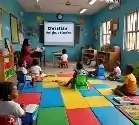Body-Building Foods Basic Science and Technology Kindergarten Second Term Week 2
Lesson Plan for Kindergarten (Age 5)
Subject: Basic Science & Technology
Class: Kindergarten
Term: Second Term
Week: 2
Age: 5 years
Topic: Body-Building Food: Proteins
Sub-topic: Types and Functions of Protein-Rich Foods
Duration: 40 Minutes
Behavioural Objectives
By the end of the lesson, pupils should be able to:
- Mention various types of food rich in protein.
- List the functions of proteins in the body.
- Identify protein-rich foods among other foods.
Keywords
Proteins, Body-building, Growth, Repair, Energy
Set Induction
The teacher shows pictures of protein-rich foods like eggs, milk, fish, beans, and meat and asks pupils to identify them.
Entry Behaviour
Pupils have eaten some protein-rich foods like eggs and milk but may not know their importance.
Learning Resources and Materials
- Pictures of protein-rich foods (e.g., eggs, beans, fish, milk, meat).
- Real samples of food items (optional).
- Audio-visual resources like video clips showing protein foods.
Building Background/Connection to Prior Knowledge
The teacher discusses common meals pupils eat daily and highlights those that contain protein.
Embedded Core Skills
- Critical Thinking
- Problem-Solving
- Communication and Collaboration
- Personal Development
Reference Books
- Lagos State Scheme of Work for Kindergarten
- Online resources:
Instructional Materials
- Pictures and charts of protein-rich foods.
- Flashcards with food names.
- Songs or rhymes about body-building foods.
Content
Definition of Proteins
- Proteins are foods that help the body grow and repair itself.
- They are called body-building foods.
Examples of Protein-Rich Foods
- Eggs
- Milk
- Beans
- Fish
- Meat
Functions of Proteins
- Help the body grow bigger and stronger.
- Repair broken parts of the body like cuts or wounds.
- Make muscles strong.
- Provide energy for the body when needed.
- Keep the body healthy and active.
Presentation Structure
Step 1: Revision of the Previous Topic
The teacher revises the last topic (Types and Importance of Food) by asking pupils to name the foods they know.
Step 2: Introduction of the New Topic
The teacher introduces the topic “Proteins” and explains that these foods help the body grow and repair itself.
Step 3: Pupils’ Contributions and Corrections
The teacher asks pupils to mention protein-rich foods they eat and guides them to identify more examples.
Teacher’s Activities
- Show pictures of different protein-rich foods and ask pupils to identify them.
- Explain the importance of proteins using simple language.
- Lead pupils in singing a rhyme about growing strong with protein foods.
- Display a chart of food groups and ask pupils to pick out protein-rich foods.
Learners’ Activities
- Look at pictures of foods and identify protein-rich ones.
- Participate in group discussions about the functions of proteins.
- Play a game where they circle protein-rich foods from a chart.
Assessment
Evaluation Questions
- What are proteins?
- Name three foods rich in protein.
- Why do we need proteins?
- Which protein food do you like most?
- Mention one way proteins help our body.
Evaluation Questions (Fill-in-the-Blank)
- Proteins are _____ foods. (a) body-building (b) energy-giving (c) sweet (d) harmful
- _____ is a protein-rich food. (a) Egg (b) Sand (c) Sugar (d) Water
- Proteins help us to _____. (a) grow (b) sleep (c) play (d) cry
- Milk is good for our _____. (a) body (b) toys (c) clothes (d) shoes
- Proteins help repair _____. (a) broken parts of the body (b) toys (c) clothes (d) cars
- Beans, fish, and meat are examples of _____. (a) proteins (b) fruits (c) drinks (d) sweets
- Proteins give us _____. (a) energy (b) toys (c) fun (d) shoes
- _____ is not a protein-rich food. (a) Sugar (b) Fish (c) Milk (d) Egg
- Protein foods help make our _____. (a) muscles strong (b) toys last (c) clothes clean (d) shoes shiny
- We need proteins to _____. (a) grow and repair (b) play and jump (c) sleep and cry (d) clean and sweep
- Fish is a source of _____. (a) protein (b) water (c) sugar (d) oil
- Meat makes us _____. (a) strong (b) tired (c) weak (d) sad
- Broken parts of the body are fixed by _____. (a) proteins (b) sugar (c) oil (d) salt
- Eating proteins keeps us _____. (a) healthy (b) sad (c) sick (d) weak
- Cheese is made from _____. (a) milk (b) beans (c) fish (d) oil
Class Activity Discussion
FAQs
- What are proteins?
Proteins are foods that help us grow and repair our body. - Why are proteins important?
They help us grow, fix broken parts, and stay healthy. - What are examples of protein-rich foods?
Eggs, milk, beans, fish, and meat. - Can proteins make us strong?
Yes, they make our muscles strong. - Why do we need milk?
Milk gives us protein to grow and stay healthy. - What food repairs our body?
Proteins repair our body. - Is rice a protein food?
No, rice is not a protein food. - What does meat do for the body?
It helps the body grow and stay strong. - Are vegetables protein-rich foods?
No, vegetables are not protein-rich foods. - Why should we eat fish?
Fish gives us protein to grow strong. - What is body-building food?
Foods that help us grow and repair the body. - Is sugar a protein?
No, sugar is not a protein. - Does protein give us energy?
Yes, it gives energy and builds the body. - What happens if we don’t eat proteins?
We may not grow well or heal quickly. - Can cheese make us grow?
Yes, cheese is a protein food.
Conclusion
The teacher moves around the class, checks pupils’ work, and gives feedback


SEO Elements
- Captivating Title: “Body-Building Foods for Kids: Learning About Proteins”
- Focus Keyphrase: “Body-Building Foods for Kids”
- Body Protective Foods Basic Science and Technology Kindergarten Second Term Week 4
- SEO Title: “Body-Building Foods for Kids: Proteins for Growth and Repair”
- Slug: body-building-foods-kids-proteins
- Meta Description: “Discover a fun lesson on body-building foods for kids! Learn about protein-rich foods, their types, and importance with examples and activities.”
- Mid-Term Assessment and Break Basic Science and Technology Kindergarten Second Term Week 6
Related posts:
- Second Term Examination Basic Science and Technology Kindergarten Week 12
- Second Term Revision Basic Science and Technology Kindergarten Week 11
- Air and Breathing Basic Science and Technology Kindergarten Week 10
- Body Protective Foods Basic Science and Technology Kindergarten Second Term Week 4
- Energy-Giving Foods Basic Science and Technology Kindergarten Second Term Week 3
Related Posts


Adam and Eve Story Christian Religious Studies Kindergarten First Term Lesson Notes Week 2


Atunyewo Eko (Revision) Yoruba Kindergarten First Term Lesson Notes Week 11


Mid Term Test Christian Religious Studies Kindergarten First Term Lesson Notes Week 7
About The Author
Edu Delight Tutors
Am a dedicated educator with a passion for learning and a keen interest in technology. I believe that technology can revolutionize education and am committed to creating an online hub of knowledge, inspiration, and growth for both educators and students. Welcome to Edu Delight Tutors, where learning knows no boundaries.
